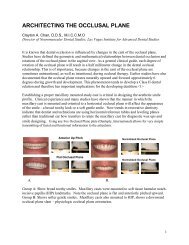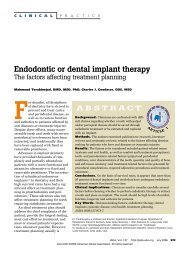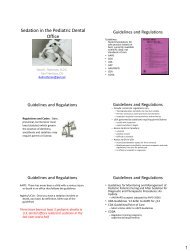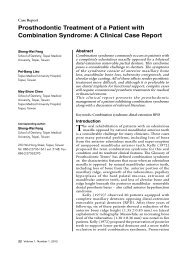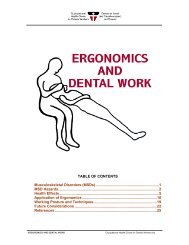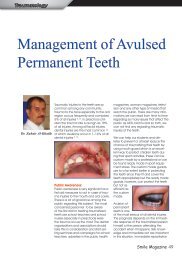BioDentine%20FBronnec%20case%20report%20ENG2
BioDentine%20FBronnec%20case%20report%20ENG2
BioDentine%20FBronnec%20case%20report%20ENG2
You also want an ePaper? Increase the reach of your titles
YUMPU automatically turns print PDFs into web optimized ePapers that Google loves.
After 7 days, the tooth was without symptoms and the canals could be dried. The session<br />
started with repair of the perforation to avoid any risk of contamination with endodontic<br />
cement when obturating the canals. The canal orifices were isolated with cotton pellets, and<br />
the dentin defect was filled with 2 layers of BioDentine using an amalgam carrier. The<br />
material was then adapted to the cavity with a cotton pellet without pressure. Once the<br />
material had set any excess material was stripped off with a curette before removing the<br />
cotton pellets and filling the root canal in the same session. At the end of the session, the<br />
hardened material was shaped with a bur to reproduce the pulp floor convexity for the future<br />
restoration of the tooth. The copper band was removed and replaced by a temporary metal<br />
cap luted with glass ionomer cement. Follow-up at three months showed no clinical signs,<br />
and the X-ray confirmed complete healing of the apical and furcation lesions.<br />
Repair of a recent perforation caused during primary endodontic treatment of a<br />
necrotic tooth<br />
A male patient was referred for emergency treatment by his dentist who could not account for<br />
unexpected bleeding when trying to find the mesio-buccal canal of the right lower 2 nd molar.<br />
The tooth was pain-free, probing depth was normal. Radiographic examination revealed a<br />
periapical lesion, and the fusion of the mesial and distal roots of this second molar suggested a<br />
C-shaped canal.<br />
After removal of the temporary filling and pre-endodontic restoration of the crown, the access<br />
cavity was extended for complete view of the pulp floor. Inspection revealed an accidental<br />
perforation of the pulp floor. The tooth being only slightly decayed, it was decided to carry<br />
out a complete preparation of the root canal system before managing the endo-perio<br />
communication. As the site of the perforation was at a safe distance from the canal orifices,<br />
the root canals could be filled before repair of the perforation. Repair of the dentin defect was<br />
then achieved by placing an increment of BioDentine with an amalgam carrier and adapting it<br />
to the wall with a cotton pellet. Once the BioDentine had set hard, excess material was<br />
eliminated with a curette. The access cavity was filled with a 3 mm layer of glass ionomer<br />
cement covered by composite material.<br />
Endodontic surgery after failure of orthograde endodontic retreatment (Fig. 5a to e)<br />
A male patient presented with symptoms that persisted despite previous orthograde<br />
retreatment. The right upper lateral incisor was restored with a post and core buildup, and a<br />
temporary crown has been in place for a few months. Radiographs before retreatment and 3<br />
months later showed a persistent periapical lesion and inflammatory root-end resorption.<br />
Since obturation of the canal system seemed radiographically adequate, surgical retreatment<br />
was opted for.<br />
After raising a full-thickness flap using an incision in the attached gingiva, access to the<br />
defect was obtained with a tungsten-carbide bur in a turbine handpiece with water spray. The<br />
lesion was curetted before resection of the apical 3 mm of the root. After verifying the<br />
absence of any root fractures, the gutta percha and cement filling was removed from the root<br />
canal up to the level of the root post. The canal was instrumented to 6 mm using ultrasonic<br />
tips (EndoSuccess Apical Surgery Kit, Actéon-Satélec, Mérignac, France). After<br />
decontamination and drying of the root cavity, retrograde obturation was completed placing 3<br />
layers of BioDentine with the use of a syringe-mounted carrier system (MAP-system, PDSA,<br />
Vevey, Switzerland). The successive portions of material were deposited in the root end<br />
cavity and adapted to the wall with root canal pluggers. After hardening of the material, a red<br />
(fine) diamond bur was used to surface the root cross-section and eliminate any excess<br />
material. Bleeding into the bone cavity was ensured before repositioning and closure of the<br />
flap with interrupted synthetic sutures (polypropylene 5/0 and 7/0, B Braun, Germany).



